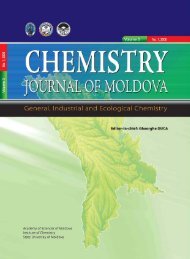2011, nr. 3 - Academia de ÅtiinÅ£e a Moldovei
2011, nr. 3 - Academia de ÅtiinÅ£e a Moldovei
2011, nr. 3 - Academia de ÅtiinÅ£e a Moldovei
Create successful ePaper yourself
Turn your PDF publications into a flip-book with our unique Google optimized e-Paper software.
Ştiinţe MedicaleBibliografie selectivă1. Chiriac Rodica, Codrina Ancuţa. Artroza. Iaşi,2005, 386 p.2. Lâsâi L. Biochimie medicală (ed. a 2-a). Cap.VIII. Biochimia sângelui şi a unor ţesuturi. Ed. Universul,Chişinău, 2007, 598 p.3. An<strong>de</strong>rsson H. I., Le<strong>de</strong>n I. Increased serum uricacid – a marker of non-gouty wi<strong>de</strong>spread pain. A study offemale patients with infl ammatory and non-infl ammatorypain. În: Scand. J. Rheumatol., 2006, 35, p. 161– 167.4. Dick Heinegard, Pilar Lorenzo, Tore Saxne. Articularcartilaje. Rheumatology, 2007, 2056 p.5. Andrianakos A.A., Kontelis L.K., KaramitsosD.G. et al. Prevalence of symptomatic knee, hand, and hiposteoarthritis in Greece. The ESORDIG study. În: J. Rheumatol.,2006, 33, p. 2507–2513.6. Dormuth C. R., Carney G., Carleton B., BassettK., and Wright J. M. Thiazolidinediones and Fracturesin Men and Women. În: Arch. Intern. Med., 2009, 169, p.1395-1402.7. Janghorbani M., Van Dam R. M., Willett W. C.,and Hu F. B. Systematic Review of Type 1 and Type 2 DiabetesMellitus and Risk of Fracture. În: Am. J. Epi<strong>de</strong>miol.,2007, 166, p. 495-505.8. Strotmeyer E. S., Cauley J. A., Schwartz A. V.,Nevitt M. C., Resnick H. E., Bauer D. C., Tylavsky F. A.,N. <strong>de</strong> Rekeneire,. Harris T. B, and Newman A. B. NontraumaticFracture Risk With Diabetes Mellitus and ImpairedFasting Glucose in Ol<strong>de</strong>r White and Black Adults: TheHealth, Aging, and Body Composition Study. În: Intern.Med., 2005, 165, p. 1612-1617.9. Prisby R. D., Swift J. M., Bloomfield S. A., HoganH. A. and Delp M. D. Altered bone mass, geometryand mechanical properties during the <strong>de</strong>velopment andprogression of type 2 diabetes in the Zucker diabetic fattyrat. În: J. Endocrinol., 2008, 199, p. 379-388.RezumatÎn diabetul zaharat (DZ) afectarea sistemului osteoarticularse î<strong>nr</strong>egistrează foarte frecvent (până la 77,8%). Osteoartropatiadiabetică se <strong>de</strong>zvoltă, <strong>de</strong> obicei, după 6-10 ani<strong>de</strong> la <strong>de</strong>butul DZ şi apare în<strong>de</strong>osebi la pacienţii cu o evoluţielabilă a diabetului. În <strong>de</strong>zvoltarea osteoartropatiei rolulcentral îl joacă insuficienţa insulinică, <strong>de</strong>reglarea metabolismelorproteic, glucidic şi mineral, <strong>de</strong>reglările hormonaleşi angioneuropatia, care induc un <strong>de</strong>zechilibru în activitateaosteoblastelor şi osteoclastelor. În final se produc leziunicronice la nivelul ţesutului articular şi celui osos, cu niştecosturi medicale şi sociale semnificative, cu rate sporite <strong>de</strong>morbiditate şi mortalitate.195SummaryOsteoarticular system damage in diabetes is frequentlyrecor<strong>de</strong>d (up to 77.8%). Diabetic osteoarthropathy<strong>de</strong>velops, usually after 6-10 years after onset diabetes andoccurs mainly in patients with labile diabetes <strong>de</strong>velopment.Insulin insufficiency plays a central role in <strong>de</strong>velopment ofjoint damage, impaired protein metabolisms, carbohydrateand mineral, hormonal disor<strong>de</strong>rs and angio-neuropathyinducingactivity imbalance in osteoblasts and osteoclasts.Finally chronic injuries occur in the bone tissue andjoint health and significantly social costs with increasedmorbidity and mortality rate.РезюмеПовреждения костно-суставной системы при сахарномдиабете регистрируются довольно часто (до77,8%). Диабетическая остеоартропатия развивается,как правило, через 6-10 лет после начала диабета ипроисходит в основном у пациентов с сахарным диабетомлабильного течения. Развитие инсулиновой недостаточностииграет центральную роль в развитииостеоартропатии, с нарушением обмена веществ белков,углеводов, c минеральными, гормональными расстройствами,а также ангио-нейропатии, вызывающиедисбаланс в активности остеобластов и остеокластов.Наконец развиваются хронические деструктивные измененияв костной ткани и хряще суставов, что приводитк значительным социальным издержкам, с повышеннойзаболеваемостью и смертностью.AFECTAREA CARDIACĂ LA PACIENŢIICU SCLERODERMIE SISTEMICĂ_______________________________________Svetlana Agachi, 1 conf. univ., dr. med,Liliana Groppa, 1 prof. univ., dr. hab., şefclinică, Larisa Rotaru, 1 conf. univ., dr. mmed.,Oxana Bujor, 2 şef secţie1USMF “Nicolae Testemiţanu”2Spitalul Clinic RepublicanÎntroducere. Sclero<strong>de</strong>rmia sistemică (Scl) esteo maladie generalizată a ţesutului conjunctiv, caracterizatăprin <strong>de</strong>zvoltarea manifestărilor patologicecutanate, ale aparatului locomotor, organelor interne(cordului, pulmonilor, rinichiilor, tractului gastrointestinal)şi a <strong>de</strong>reglărilor vasospastice difuze, cauzate<strong>de</strong> afectarea ţesutului conjunctiv cu predominarea fibrozeişi <strong>de</strong> alterarea vasculară <strong>de</strong> tipul microangiopatieiobliterante.Manifestările sclero<strong>de</strong>rmiei sistemice sunt diverseatât ca număr, cât şi după exprimarea lor clinică,oscilând <strong>de</strong> la forme reduse cu prognostic favorabilpână la variante generalizate şi fatale.Afectarea cordului este una dintre cauzele morţiisubite la pacienţii cu Scl.Conform bazei <strong>de</strong> date EUSTAR, moartea pacienţilorcu Scl este cauzată <strong>de</strong> fibroza pulmonară în35% din cazuri, hipertensiune pulmonară izolată şimiocardiopatie în 26% fiecare; <strong>de</strong> criza renală sclero<strong>de</strong>rmică– în 8% şi <strong>de</strong> afecţiunile gastrointestinale –în 5%. Dintre cei <strong>de</strong>cedaţi <strong>de</strong> miocardiopatie, 42% au
















